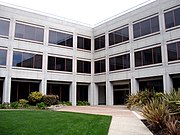
Image via CrunchBase
Without a doubt my most often used web application is Google’s gmail.
Gmail is a free POP3 and IMAP webmail service provided by Google.[1][2] In the United Kingdom and Germany it is officially called Google Mail.
Gmail launched on 1 April 2004 as an invitation-only beta release and became available to the general public on 7 February 2007. Although tens of millions of users [3][4][5] have taken advantage of stable releases for many months, to this day[update] the service remains in beta status.
With an initial storage capacity offer of 1 GB per user, Gmail increased the webmail standard for free storage from the 2 to 4MB its competitors offered at that time. The service currently offers over 7250 MB of free storage with additional storage ranging from 10 GB to 400 GB available for $20 to $500 (US) per year.[6][7][8]
Gmail has a search-oriented interface and a "conversation view" similar to an Internet forum. Software developers know Gmail for its use of the Ajax programming technique.[9]
Gmail runs on the Google GFE/1.3 server which runs on Linux
Features
Storage
Gmail login page
The Gmail service currently provides more than 7200 MB of free storage[6]. Additional storage is available from 10 GB (US$20/year) to 400 GB (US$500/year), shared between Picasa Web Albums and Gmail.[12] The increase from 1 GB was announced on 1 April 2005, the first anniversary of Gmail. The announcement was accompanied by a statement that Google would "keep giving people more space forever."[13]
Google presently[when?] says it will keep increasing storage by the second as long as it has enough space on its servers. On 12 October 2007, Google ramped up the storage counter to 5.37 MB per hour.[14]
Approximately a week later, the counter went back down to 1.12 MB per hour. On 4 January 2008, the counter went down to about 3.35 MB per day, or 0.14 MB per hour. From October 2008, the counter went down to about 353.9 KB per day.
Gmail Labs
The Gmail Labs feature, introduced on 5 June 2008, allows users to test new or experimental features of Gmail, such as bookmarking of important e-mail messages, custom keyboard-shortcuts and games.
Users can enable or disable Labs features selectively and provide feedback about each of them. This allows Gmail engineers to obtain user input about new features to improve them and also to decide which ones are popular and worth developing into regular Gmail features. All Labs features are experimental and are subject to termination at any time. Labs features can only be used in the English language interface of Gmail.
On 10 December 2008, Gmail added support for SMS Messaging through its integrated Chat.[15][16][17]
Spam filter
Gmail's spam filters include a community-driven system, where emails marked as spam by one user provide information to help the system block similar future messages for all Gmail users. [18]
Interface
-
Main article: Gmail interface
The Gmail interface is unique amongst webmail systems for several reasons. Most evident to users are its search-oriented features and means of managing e-mail in a "conversation view" that is similar to an Internet forum.
History
-
Main article: History of Gmail
Gmail was a project started by Google developer Paul Buchheit several years before it was announced to the public. Initially the software was available only internally as an e-mail client for Google employees. Google finally announced Gmail to the public on 1 April 2004.[19]
Domain name
Before its acquisition by Google, the gmail.com domain name was used by a free e-mail service offered by Garfield.com, online home of the comic strip Garfield. After moving to a different domain, that service has since been discontinued.[20]
As of 22 June 2005, Gmail's canonical URI changed from http://gmail.google.com/gmail/ to http://mail.google.com/mail/.[21]
The domain gmail.com is unavailable in certain countries, in which cases users are able to use the domain googlemail.com. The Gmail service does not discriminate between these two domains for incoming e-mails, therefore a user with the address "john.doe@googlemail.com" will receive mail sent to "john.doe@gmail.com", and vice-versa. Accordingly, users obliged to use the googlemail.com domain are unable to select addresses already chosen by gmail.com users.
Gmail hoaxes
Gmail Paper hoax
On April Fools' Day 2007, Google made fun of Gmail by introducing "Gmail Paper", where a user could click a button and Gmail would purportedly mail an ad-supported hard copy for free.[22]
[edit] Gmail Custom Time hoax
On April Fools' Day 2008, Google introduced a fake service named Gmail Custom Time, which would allow a user to send up to ten e-mails per year with forged timestamps. The hoax stated that by bending spacetime on the Google servers, the e-mails are actually routed through the 4th dimension of time itself prior to reaching their intended recipient.[23][24][25]
Code changes
Gmail's JavaScript front-end was rewritten in late summer and early fall of 2007 and was released to users starting on 29 October 2007. The new version had a redesigned contacts section, quick contacts box and chat popups, which were added to names in the message list as well as the contact list. The contacts application is integrated into other Google services, such as Google Docs. Users granted access to the new version were given a link at the top-right corner which read "Newer Version". As of December 2007, most new registrations in English (US) along with most pre-existing accounts are given the new interface by default when supported. There remains the option to downgrade via a link labelled "Older Version".[26][27][28][29]
These coding changes mean that only users of Internet Explorer 7, Firefox 2, Google Chrome and Safari 3.0 (or more recent versions) can fully use the new code. Internet Explorer 5.5+, Netscape 7.1+, Mozilla 1.4+, Firefox 0.8, Safari 1.3 and some other browsers will give limited functionality. Other browsers may be redirected to the basic-HTML-only version of Gmail.[28][30][31][32][33]
In the week of 18 January 2008, Google released an update that changed the way Gmail loads JavaScript. This caused the failure of some third-party extensions.[34]
On December 12, 2008, Gmail added support for faster PDF viewing within the browser.[35]
Criticisms
Privacy
Google automatically scans e-mails to add context-sensitive advertisements to them. Privacy advocates raised concerns that the plan involved scanning their personal, assumed private, e-mails, and that this was a security problem. Allowing e-mail content to be read, even by a computer, raises the risk that the expectation of privacy in e-mail will be reduced. Furthermore, e-mail that non-subscribers choose to send to Gmail accounts is scanned by Gmail as well and these senders did not agree to Gmail's terms of service or privacy policy. Google can change its privacy policy unilaterally and Google is technically able to cross-reference cookies across its information-rich product line to make dossiers on individuals. However, most e-mail systems make use of server-side content scanning in order to check for spam.[36][37]
Privacy advocates also regard the lack of disclosed data retention and correlation policies as problematic. It is possible for Google to combine information contained in a person's e-mails with information about their Internet searches. It is not known how long such information would be kept and how it could be used. One of the concerns is that it could be of interest to law enforcement agencies. More than 30 privacy and civil liberties organizations have urged Google to suspend Gmail service until these issues are resolved.[38]
Some commentators[39] have criticised Gmail's privacy policy, which contains the clause: "Residual copies of deleted messages and accounts may take up to 60 days to be deleted from our active servers and may remain in our offline backup systems." Google continues to reply to this criticism by pointing out that Gmail is using mostly industry-wide practices. Google later stated that they will "make reasonable efforts to remove deleted information from our systems as quickly as is practical."[40][41]
As part of Gmail's privacy policies, Google states that Gmail will refrain from displaying ads next to potentially sensitive messages. [42] Content that suppresses ads includes news about a tragedy, an e-mail about catastrophic events and death announcements.[citation needed] Critics[who?] argue that the fact remains that these e-mails are being scanned in order for Gmail's systems to identify the fact that the e-mail is of this type.
Technical issues
Gmail does not allow users to send or receive executable files or archives containing executable files if it recognises the file extension as one used for executable files or archives.
Tech-savvy users who are not prone to casual errors report loss of random messages in random amounts.[43][44]
By design, Gmail does not deliver all of a user's e-mails. When downloading mail through POP or IMAP access, Gmail fails to deliver messages that users have sent to themselves.[45] It also does not deliver to a user's inbox (via any access interface) those messages that users have sent to mailing lists and which they might expect to receive back via the mailing list.[46]
Gmail filters cannot use custom header names. This limitation was significant before Gmail added support for identifying incoming messages sent to a mailing list: some mailing list manager programs, such as the Mailman used by SourceForge, add a custom header to the messages they distribute, but do not change the "Subject". Gmail filters can check for a string in the "Subject", but not in a custom header.[citation needed]
"On behalf of"
With the current Gmail implementation, any email sent from the Gmail interface will include the Gmail.com address as the "sender", even if the sending account is a custom email account. For example, an email sent from an external account via the Gmail interface will display to the user as From user@gmail.com on behalf of user@OtherDomainEmailAddress.com. By exposing the gmail account name, Google claims that this will "help prevent mail from being marked as spam".[47] A number of Gmail users have complained that this implementation is both a privacy concern and a professionalism problem.[48][49][50]
Awards
Gmail was ranked second in PC World's "100 Best Products of 2005," behind Mozilla Firefox. Gmail also won 'Honorable Mention' in the Bottom Line Design Awards 2005.[51][52]
Gmail has drawn many favorable reviews from users for generous space quotas and unique organization.[53]


![Reblog this post [with Zemanta]](http://img.zemanta.com/reblog_e.png?x-id=02b54b2f-5efe-4ef5-b678-01015dc13bc8)









 At the beginning of each year I traditionally publish a list of my favorite startups and products. This is the fourth year I’ve done this - previous lists:
At the beginning of each year I traditionally publish a list of my favorite startups and products. This is the fourth year I’ve done this - previous lists: 
![Reblog this post [with Zemanta]](http://img.zemanta.com/reblog_e.png?x-id=6e2b0235-411b-4178-99c2-3569524969ba)



